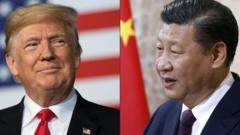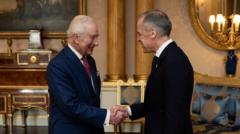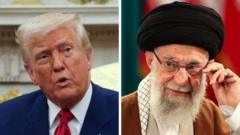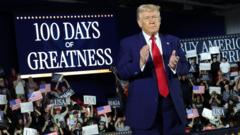The US and China are entangled in a trade war characterized by high tariffs and a reluctance to engage in open negotiations. While both sides recognize the need for de-escalation, neither wants to appear weak by making the first move. The potential for future talks exists, but both leaders aim to save face domestically while addressing the impacts of the trade war.
The US-China Trade War: Who Will Take the First Step in Negotiations?

The US-China Trade War: Who Will Take the First Step in Negotiations?
As tariffs soar and economic pressures rise, both the US and China navigate a complex stalemate in their trade negotiations.
In the early hours of Thursday morning, Chinese state media reported that the United States had initiated efforts to engage in tariff negotiations with China, stoking global interest amid one of the most high-stakes trade conflicts in history. Tariffs on some Chinese exports coming into the US have escalated to as much as 245%, straining economic relations between the two superpowers and creating fears of an impending recession.
According to a post on Weibo, an account associated with China Central Television (CCTV), the Trump administration has been using various channels to reach out to Beijing. The account quoted unnamed sources, indicating attempts at diplomacy that contradict recent claims by President Trump, who suggested that conversations were already occurring—a point China has refuted.
In a notable response, Yuyuantantian declared, "China has no need to talk to the United States," asserting that the US finds itself in a more anxious position currently. This back-and-forth signals a delicate dance between two nations reluctant to appear overly eager to negotiate despite shared interests in resolving the conflict.
Analysts see this communication breakdown as a metaphorical game of chicken between President Trump and Chinese President Xi Jinping. Both leaders strive to uphold their domestic images, making any form of compromise appear like a concession. Ja Ian Chong, from the National University of Singapore, conveyed that while both sides will resist appearing weak, they ultimately share a common goal: de-escalation.
The escalation of tariffs has posed challenges for both parties. Trump's administration faces concerns of recession just as US retailers like Walmart warn of rising prices and dwindling stock. Simultaneously, Xi is confronted with economic issues such as low consumption, a property crisis, and unemployment—challenges aggravated by the ongoing trade war.
According to Wen-Ti Sung from the Australian Centre on China in the World, a potential way out of the current impasse could involve indirect communication methods or mediation by a third party, allowing negotiation to start without either leader conceding publically. "Both sides want to portray the other as more desperate," Mr. Sung emphasized.
While there are signs of communication between the two nations, ultimately, experts warn that both leaders may continue to stall until one side decides to make the first overture. "Posturing" may persist unless they find mutual concessions, creating an ongoing standoff as each waits to see who will blink first.
According to a post on Weibo, an account associated with China Central Television (CCTV), the Trump administration has been using various channels to reach out to Beijing. The account quoted unnamed sources, indicating attempts at diplomacy that contradict recent claims by President Trump, who suggested that conversations were already occurring—a point China has refuted.
In a notable response, Yuyuantantian declared, "China has no need to talk to the United States," asserting that the US finds itself in a more anxious position currently. This back-and-forth signals a delicate dance between two nations reluctant to appear overly eager to negotiate despite shared interests in resolving the conflict.
Analysts see this communication breakdown as a metaphorical game of chicken between President Trump and Chinese President Xi Jinping. Both leaders strive to uphold their domestic images, making any form of compromise appear like a concession. Ja Ian Chong, from the National University of Singapore, conveyed that while both sides will resist appearing weak, they ultimately share a common goal: de-escalation.
The escalation of tariffs has posed challenges for both parties. Trump's administration faces concerns of recession just as US retailers like Walmart warn of rising prices and dwindling stock. Simultaneously, Xi is confronted with economic issues such as low consumption, a property crisis, and unemployment—challenges aggravated by the ongoing trade war.
According to Wen-Ti Sung from the Australian Centre on China in the World, a potential way out of the current impasse could involve indirect communication methods or mediation by a third party, allowing negotiation to start without either leader conceding publically. "Both sides want to portray the other as more desperate," Mr. Sung emphasized.
While there are signs of communication between the two nations, ultimately, experts warn that both leaders may continue to stall until one side decides to make the first overture. "Posturing" may persist unless they find mutual concessions, creating an ongoing standoff as each waits to see who will blink first.


















